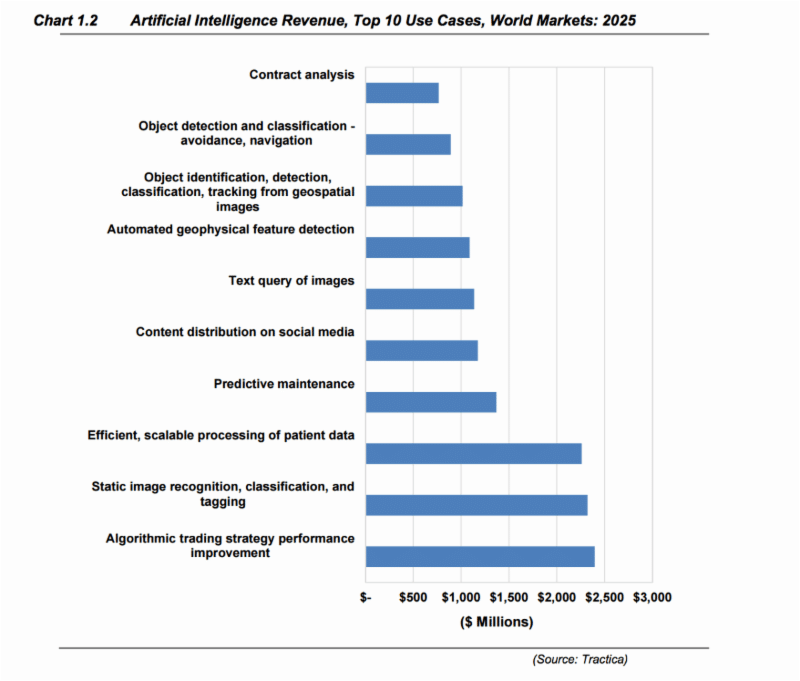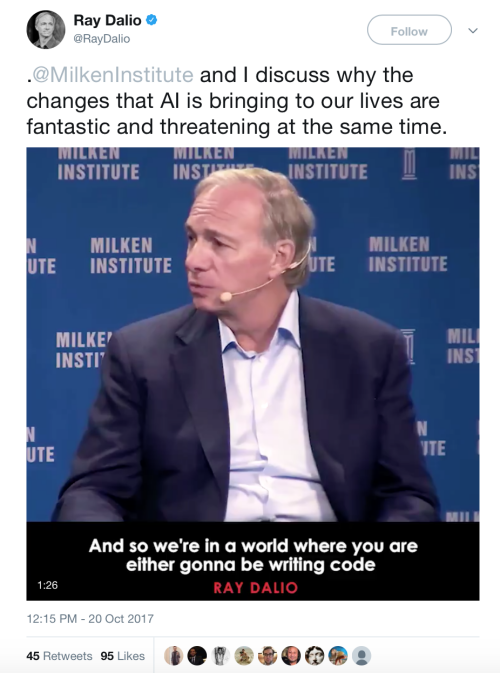If you own an Android phone, there may be an A.I. Robocop scouring your device to trap and destroy malware right now. There is no one sitting in a cubicle doing this, it is ‘machine learning.’
Consider this:
At the beginning of 2017, about 0.6% of Android’s two billion user base was infected by malware. Just ten months later, and with no new man power needed, that figure has dropped to 0.25%, thanks to Google’s A.I. software.

A.I. and Machine Learning to Render Millions Jobless
A.I. is the reason that, in twenty years or less, we won’t be driving cars. We’ll merely be passengers. Artificial intelligence autonomous vehicle platforms, engineered and remotely updated by every car company on the planet, will be driving for us. Those autonomous cars we will be sitting in as we go to and from work are being street tested across the world right now. They are accumulating data from the roads, learning emergency response maneuvers and how to avoid unruly human drivers; from making multiple stops to picking people up, essentially transforming the definition of carpooling while removing the need for Uber, taxi and bus drivers…
A.I., combined with the Internet of Things, will make technologies which seem impossible today, rudimentary in the future. From healthcare to defence and banking, A.I. will transform industries which are responsible for more than half of the world’s GDP. The impact in the stock market, and for leaders in this space, just like the capabilities of A.I. and IoT, will be unimaginable.
A.I. and IoT to Lead Fourth Industrial Revolution
The markets for A.I. and IoT are in their infancy. The global artificial intelligence market was valued at more than US$179 billion in 2016 and is expected to reach around US$968 billion by 2021, according to Technavio.
Technavio is not alone in this prediction. Numerous other firms have made similar estimates. According to a recent update of the Worldwide Semiannual Cognitive Artificial Intelligence Systems Spending Guide from International Data Corporation, “…spending is expected to achieve a compound annual growth rate (CAGR) of 50.1% over the 2016-2021 forecast period.”
That kind of spending growth leads to an intense acquisition period. We’ve met with a handful of private startups in the A.I. space over the last several months and can tell you that their top talent, and companies, are being targeted by major corporations in Canada and the U.S.
Big, sleepy corporations intend to enter the A.I. space via acquisition, as they often do with new sectors they know very little about. Millionaires and billionaires will be made as A.I. expands into the mainstream. Multinationals with no experience in A.I. (and large treasuries) are being forced to adapt or die as competitors innovate.
Check out Spiderbook’s data visualization of companies investing in A.I.:
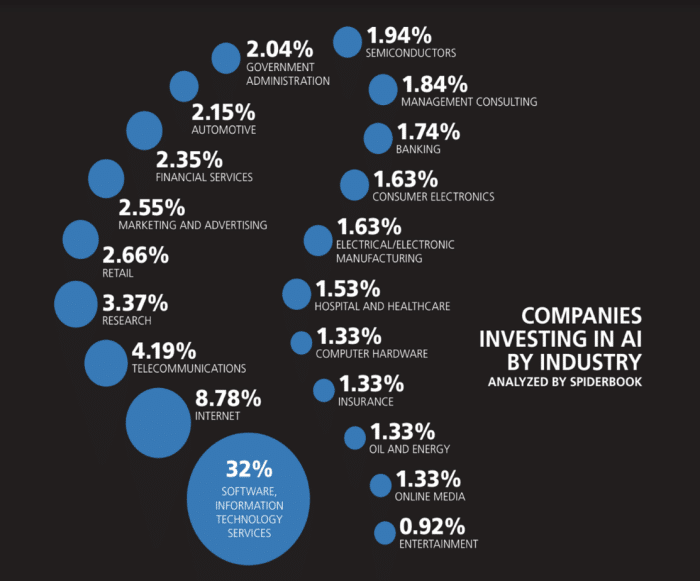
While the total market value is one thing, revenue generation is another. Let’s take a quick look at the A.I. software market… according to Tech Emergence:
“Tractica forecasts that the revenue generated from the direct and indirect application of AI software is estimated to grow from $643.7 million in 2016 to $36.8 billion by 2025. This represents a significant growth curve for the 9-year period with a compound annual growth rate (CAGR) of 56.8%.”
Tractica’s top 10 A.I. use cases and their projected revenue in 2025:
While much of this growth is forecasted and yet to occur, investors are not waiting. Take NVIDIA for example…

NVIDIA is the poster boy for A.I. and is one of the most liquid, valuable A.I.-focused stocks in the world. It ran from roughly $12 in late-2013 to nearly $200 on the NASDAQ this month.
NVIDIA’s chips and CUDA programming platform are driving the next generation of computer intelligence, specifically in self-driving cars.
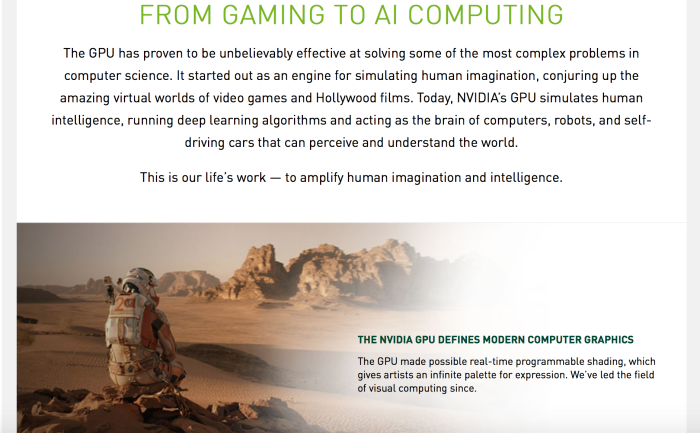
A.I. | Self-Driving Cars Dominate Headlines… for now
According to Business Insider, companies, including Tesla, “are using Nvidia’s “Drive” platform to process visual data from the road and translate that into decisions on how to drive the car.”
In May, NVIDIA announced a deal with Toyota Motor. The companies are collaborating to deliver A.I. hardware and software technologies to facilitate.
“While NVIDIA works with other companies on AI and autonomous vehicles, their deal with Toyota is significant, as they are one of the largest automakers in the world. Toyota will be using NVIDIA’s DRIVE PX computer chip for AI cars.”

Still Underestimating A.I.? Read This.
In September, Business Insider published an article titled Everyone ‘severely underestimates the impact of AI’ – here’s why Nvidia could soar to $250 (NVDA). The target, given by Evercore, suggests the company was about $45 billion undervalued at the time. These are huge numbers. In that same article, writer Seth Archer attempts to describe just how all-encompassing A.I. will be in the coming years:
“While augmented reality might give you directions to your favorite coffee shop overlaid on the sidewalk in front of you, artificial intelligence could realize that you are on your way, brew up your favorite order, and automatically charge your account as soon as you pick up your latte.”
While you ponder not even having to speak to order your favorite brew, a seemingly trivial activity, consider this:
According to Ujjwal Doshi, a lead analyst for media and entertainment research at Technavio, “The growing development of the deep learning technology has enabled the execution of complex functions such as high-speed data processing, image recognition, and voice recognition.”
Dubbed ‘The Fourth Industrial Revolution,’ A.I. technologies are to assist human beings in deliberating, deducing, analyzing, and inventing new technologies, according to Orbis Research.
Notice that last point: inventing new technologies. Machine learning, at some point by mid-century, is anticipated to speed up technological advancements in many sectors by an order of magnitude compared to today’s pace (which is already impressive)…
It’s hard to imagine what future inventions A.I. may create. Likewise the ripple effect in economic output it could produce.
Technological Singularity to Drive Interest in A.I.
As an aside, to understand the true potential of A.I., we encourage you research the theory known as ‘technological singularity.’ In short, according to Wikipedia, “The technological singularity (also, simply, the singularity) is the hypothesis that the invention of artificial superintelligence will abruptly trigger runaway technological growth, resulting in unfathomable changes to human civilization.”
The MIT Press reported, “The idea that human history is approaching a “singularity”-that ordinary humans will someday be overtaken by artificially intelligent machines or cognitively enhanced biological intelligence, or both-has moved from the realm of science fiction to serious debate. Some singularity theorists predict that if the field of artificial intelligence (AI) continues to develop at its current dizzying rate, the singularity could come about in the middle of the present century…”
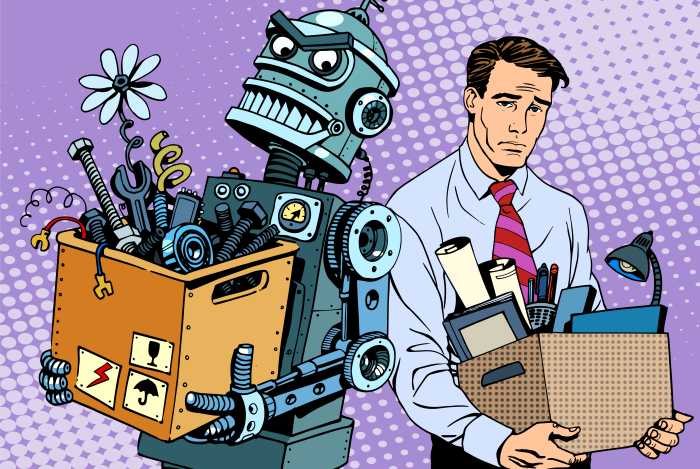
“Analysts forecast the Global Artificial Intelligence (AI) Market to Grow at a CAGR of 50.51% During the Period 2017-2021,” according to a report by Orbis Research.
A.I. and IoT | Ultimate High Growth Sectors
A.I., followed closely by IoT, are two sectors that will experience the greatest growth through to 2025. As investors, to not be researching these sectors is downright foolish. Companies large and small are upgrading their services/products by incorporating A.I. or IoT, or both. If you aren’t overly familiar with either term, this Volume is for you.
Quick definitions before we go further:
Merriam-Webster defines artificial intelligence as:
“a branch of computer science dealing with the simulation of intelligent behavior in computers”
or
“the capability of a machine to imitate intelligent human behaviour”
From assembly robots to self-driving cars, A.I. will be all around us in the not too distant future. Millions of conventional jobs currently done by humans will be replaced in the coming years by machines. The self-check-out aisle at the grocery store is merely a preview.
Elon Musk has gone on the record repeatedly in recent months, warning that A.I. is a bigger threat than North Korea. The SpaceX and Tesla CEO is a futurist who believes A.I. is more advanced than most people realize and poses real threats.
Speaking at the World Government Summit, Musk stated,
“Over time I think we will probably see a closer merger of biological intelligence and digital intelligence.”
Ray Dalio | Investing Opportunities in AI
Ray Dalio, arguably the most successful fund manager in American history, recently spoke at the Milken Institute about A.I.; and the threat it poses to humanity, as well as the opportunities it brings. Have a listen by clicking the image below from Dalio’s Twitter feed:
Regardless of the impending A.I. threat, digital or otherwise, there is a reason Musk and other business leaders cannot ignore it.
A.I. will be among the fastest growing industries in the world for the next decade.
Internet of Things to Complement A.I. and Vice Versa
A.I. will complement the Internet of Things and vice versa. In fact, many of the technologies will rely upon each other.
Merriam-Webster definition of Internet of Things:
“the networking capability that allows information to be sent to and received from objects and devices (such as fixtures and kitchen appliances) using the Internet”
According to the International Data Corporation (IDC) the “Worldwide Semiannual Internet of Things Spending Guide forecasts worldwide spending on the Internet of Things (IoT) to grow 16.7% year over year in 2017, reaching just over $800 billion. By 2021, global IoT spending is expected to total nearly $1.4 trillion…”
IDC explains the IoT use cases that are expected to attract the largest investments in 2017 include manufacturing operations ($105 billion), freight monitoring ($50 billion), and production asset management ($45 billion). Smart grid technologies for electricity, gas and water and smart building technologies are also forecast to see significant investments this year ($56 billion and $40 billion, respectively).
IoT Security Market | 34% CAGR
The IoT security market is expected to grow from $6.62 billion to $29.02 billion, at a CAGR of 34.4% from 2017 to 2022, according to ReportsnReports.
An aggressive growth subsector within the IoT space is the IoT platform market. i-Scoop explains it as,
“An IoT platform combines several software functions into one solution to enable companies to develop and deploy Internet of Things solutions faster, better and cheaper.”
IoT impacts the bottom line by taking much of the guess work out of running a company, government and household. For example, health monitors for out-patient care can monitor ECG, heart rate, skin temperature, fall detection, and other activity readings remotely. These devices can collect data and alert doctors in real-time to potential health problems.
According to Markets & Markets, the Internet of Things technology market by hardware, platform, software solutions, and services, application, and geography is “Expected to grow from USD 130.33 Billion in 2015 to USD 883.55 Billion by 2022, at a CAGR of 32.4% between 2016 and 2022.”
There is not just one way to play the IoT market. It is a rabbit hole of different subsectors, products and potential uses that one could never fully research. Unless, of course, you had some machine learning or A.I. to give you a hand…
A.I., Big Data and Global IoT Platform Market
A.I. and Big Data are driving interest in investment firms such as Betterment. Yes, robo-advisors are a real thing. According to the Daily Mail,
“New York-based Betterment has revealed that not only does its digital employee work with thousands of customers, but ‘a number of them are worth more than $10 million under management each.”
We are witnessing the beginning of the ‘Fourth Industrial Revolution,’ and you need to prepare… acquisitions will be a-plenty in this space.
Below is a list of key players in the global IoT platform market, according to ReportsnReports:
“Alcatel-Lucent (Nokia), Amazon Web Services (AWS), AT&T, Cisco Systems, and Microsoft Corporation. Other prominent vendors in the market are: Axiros, Accenture, Apple, Atos, Bosch (Bosch Software Innovations), Echelon, and Oracle.”
Every one of these world leading corporations will be looking to buy technologies in A.I., in addition to IoT technology, or acquire companies outright in these spaces. A dream scenario is emerging for small-cap investors.
“The investor of today does not profit from yesterday’s growth.”
– Warren Buffett
Tomorrow’s growth will be in A.I. and IoT. As a result, it’s time to begin researching companies poised to carve out their share of these ever-expanding sectors.
All the best with your investments,
PINNACLEDIGEST.COM
P.S. If you’re not already a member of our newsletter and you invest in TSX Venture stocks, what are you waiting for? Subscribe today. Only our best content will land in your inbox.
